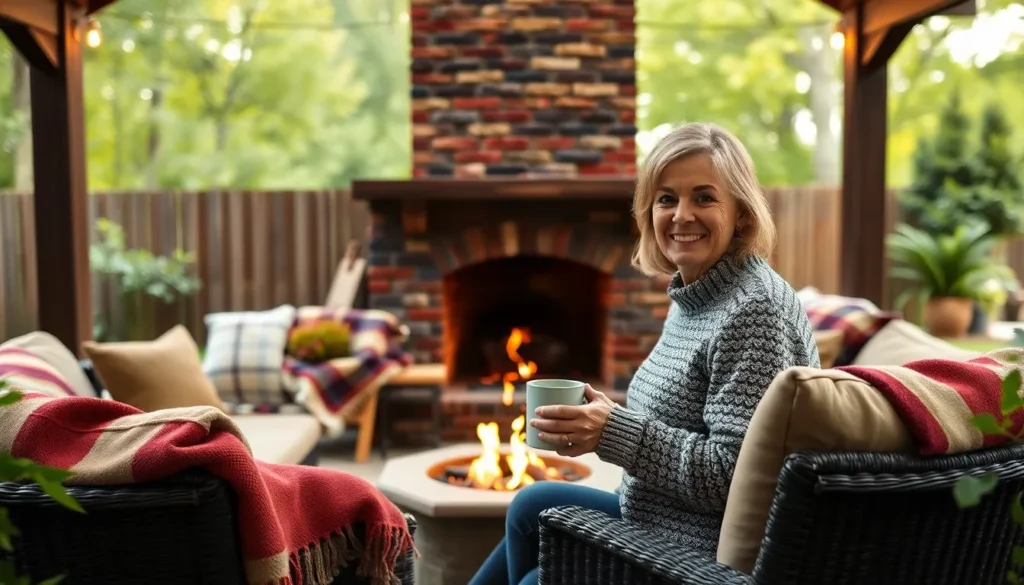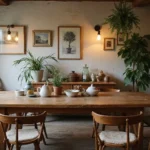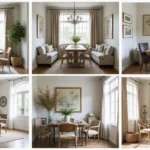There’s nothing quite like gathering around a crackling fire on a cool evening. An outdoor fireplace doesn’t just extend your living space—it transforms your backyard into a year-round retreat that adds both warmth and style to your outdoor entertainment area.
We’ve compiled some of the most stunning outdoor fireplace ideas that blend functionality with aesthetic appeal. Whether you’re looking for a rustic stone masterpiece, a sleek modern design, or a budget-friendly DIY option, you’ll find inspiration to create the perfect outdoor hearth for your space. From materials and placement to styles that complement various landscaping themes, we’ll cover everything you need to know to bring your fiery backyard vision to life.
10 Stunning Outdoor Fireplace Ideas to Transform Your Backyard
1. Classic Brick Fireplace
Brick fireplaces offer timeless appeal and exceptional durability for outdoor settings. These structures blend seamlessly with various landscaping styles while providing reliable heat distribution. You’ll find that red clay bricks create a warm, traditional atmosphere perfect for family gatherings. Standard brick designs typically cost between $2,500-$5,000 depending on size and complexity. Many homeowners choose to position brick fireplaces against existing walls to maximize space efficiency and create a natural focal point.
2. Stone Veneer Masterpiece
Stone veneer fireplaces deliver the luxurious appearance of natural stone without the hefty price tag. These stunning structures incorporate manufactured stone that’s lighter and easier to install than solid stone options. Professional installation usually ranges from $3,000-$7,000, making this a mid-range investment with high-end visual impact. Natural-looking stone patterns in grays, tans, and browns complement virtually any outdoor décor style. We’ve noticed these fireplaces particularly shine when paired with wooden pergolas or lush greenery.
3. Modern Concrete Design
Concrete fireplaces feature clean lines and minimalist styling that perfectly suits contemporary outdoor spaces. These sleek structures can be custom-formed into virtually any shape, allowing for truly personalized designs. Polished concrete surfaces provide excellent heat retention while standing up to harsh weather conditions year after year. Professional installation typically costs between $3,500-$8,000 depending on complexity and finish quality. The neutral gray tones work beautifully with metal furniture and geometric landscaping elements.
4. Rustic Chiminea Style
Chimineas bring charming southwestern flair to outdoor spaces while offering excellent smoke management. These freestanding fireplaces feature a bulbous base with a vertical chimney that effectively directs smoke upward. Clay chimineas typically range from $100-$500, while cast iron or steel versions cost between $200-$1,000. Small footprints make these perfect for patios with limited space or as secondary heat sources in larger yards. Decorated with traditional patterns or southwestern motifs, chimineas add instant character to any outdoor setting.
5. Built-In Pizza Oven Combo
Pizza oven fireplaces combine exceptional cooking functionality with cozy gathering spaces. These dual-purpose structures feature a traditional fireplace alongside a dedicated wood-fired oven compartment. Quality materials like fire brick and volcanic clay ensure optimal heat distribution for perfect pizzas every time. Professional installation ranges from $5,000-$12,000 depending on size and materials. Homeowners report these combo units becoming the central entertainment feature during outdoor gatherings throughout the year.
6. Tabletop Fire Pit Conversion
Tabletop fireplaces offer versatility and convenience for smaller outdoor spaces or temporary setups. These compact units typically use clean-burning gel fuel or propane, eliminating the need for wood storage. Prices range from $100-$500 depending on size, materials, and fuel type. Glass shields provide wind protection while improving safety around children and pets. Many designs incorporate attractive stone or ceramic bases that complement existing outdoor furniture collections.
7. See-Through Double-Sided Design
Double-sided fireplaces create stunning visual connections between different outdoor living zones. These innovative structures allow heat and ambiance to be enjoyed from multiple angles simultaneously. Glass panels often separate the two sides, providing wind protection while maintaining visibility. Installation costs typically range from $6,000-$15,000 depending on size and materials. Strategic placement between dining and lounging areas maximizes functionality while creating a natural flow between outdoor rooms.
8. Stacked Stone Column
Stacked stone column fireplaces combine architectural interest with efficient heating in a compact footprint. These vertical structures use natural or manufactured stone in various colors and textures for visual impact. Heights typically range from 5-8 feet, creating dramatic focal points without consuming excessive patio space. Professional installation costs between $4,000-$9,000 depending on materials and complexity. The vertical design naturally draws the eye upward, making outdoor spaces feel larger and more expansive.
9. Fire and Water Feature Combination
Fire and water combination features create dramatic sensory experiences that transform ordinary backyards into luxury retreats. These innovative designs incorporate waterfalls or fountains alongside fire elements for striking visual contrast. Custom installations typically range from $8,000-$20,000 depending on complexity and materials. LED lighting options can enhance nighttime ambiance with color-changing effects that reflect off both fire and water. The soothing sounds of water perfectly complement the crackling warmth of flames.
10. Portable Steel Fire Bowl
Steel fire bowls offer flexibility and modern styling at budget-friendly price points. These lightweight portable options can be repositioned seasonally to optimize outdoor enjoyment year-round. Quality models typically range from $200-$1,500 depending on size and design complexity. Many feature decorative cutouts that create fascinating shadow patterns when lit. Rust-resistant finishes in black, copper, or bronze complement various outdoor furniture styles while standing up to weather exposure.
Creating a Stone Masonry Outdoor Fireplace for Timeless Appeal
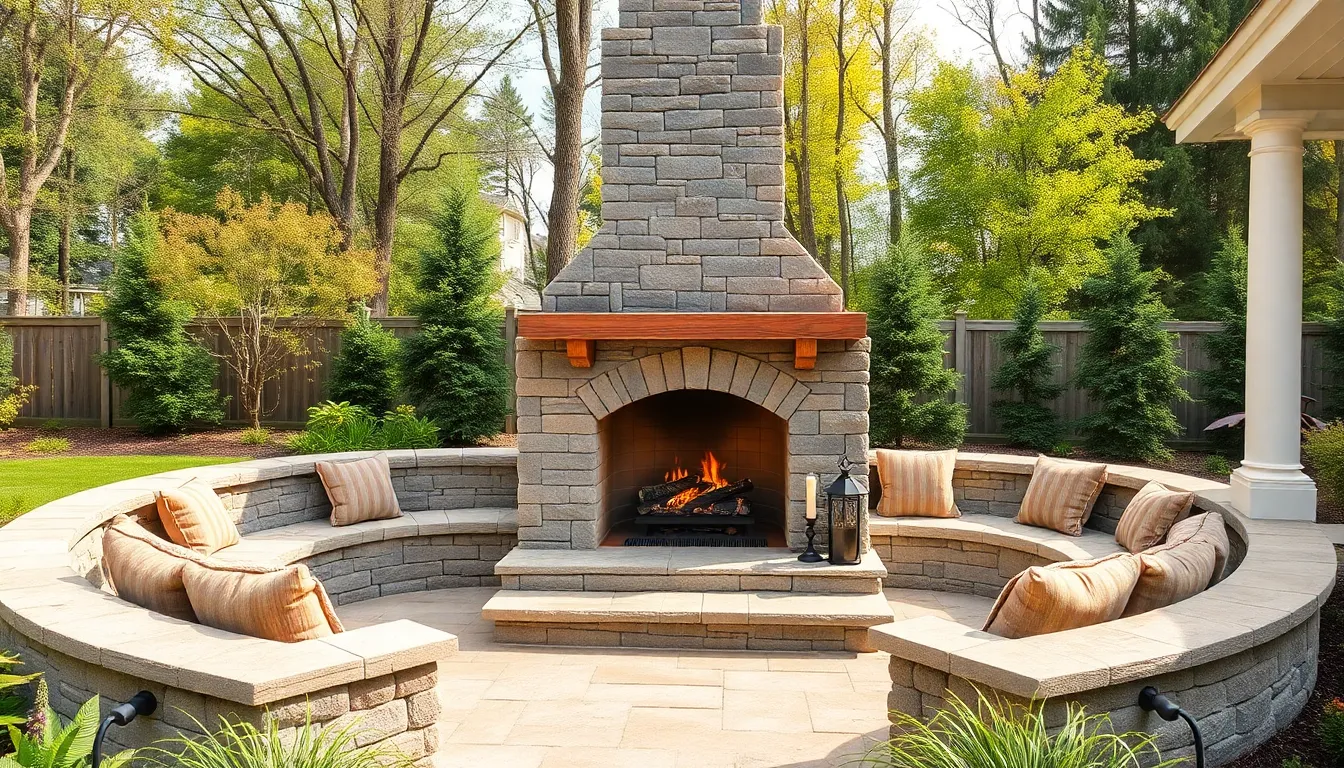
Stone masonry fireplaces offer enduring beauty and functionality that can transform any outdoor space into a luxurious retreat. We’ve compiled essential steps and considerations to help you create a stunning stone fireplace that will serve as the centerpiece of your outdoor living area for years to come.
Selecting the Right Stone Material for Your Climate
Stone selection plays a crucial role in ensuring your outdoor fireplace remains beautiful and functional regardless of weather conditions. In wetter climates, opt for highly water-resistant stones like bluestone or granite that won’t deteriorate with moisture exposure. For arid regions, limestone or travertine provide excellent options that won’t crack under intense heat or sun exposure.
Maintenance requirements should factor into your decision-making process. Stones with smooth finishes generally require less upkeep and are easier to clean when ash or soot accumulates. Consider how your chosen stone will weather over time – some materials develop a beautiful patina while others might fade or stain in ways you don’t prefer.
The aesthetic appeal of your stone should complement your home’s exterior design. Using locally sourced stone often creates the most authentic look while potentially reducing transportation costs. Remember that the stone you select will define the character of your outdoor space for decades, making this decision particularly important for long-term satisfaction.
Incorporating Built-in Seating Around Your Stone Fireplace
Built-in seating transforms your outdoor fireplace from a mere heating element into a complete entertainment zone. Design your seating as an integral part of the fireplace structure, using matching stone materials to create a cohesive, unified appearance. This approach not only maximizes your investment but also creates a custom look that appears professionally designed.
Circular seating configurations work exceptionally well around fireplaces, naturally encouraging conversation while ensuring everyone enjoys equal access to the warmth and visual appeal of the flames. This arrangement creates an intimate atmosphere perfect for gatherings of family and friends throughout the year.
Enhance comfort by adding weather-resistant cushions, throw pillows, or even built-in heating elements for cooler evenings. Strategic lighting installation around the seating area, such as string lights or lanterns, creates additional ambiance when the sun sets. Incorporating thoughtful landscaping with plants or trees can further establish a natural, secluded atmosphere that makes your outdoor fireplace feel like a private retreat within your own yard.
Designing a Modern Concrete Outdoor Fireplace for Contemporary Spaces
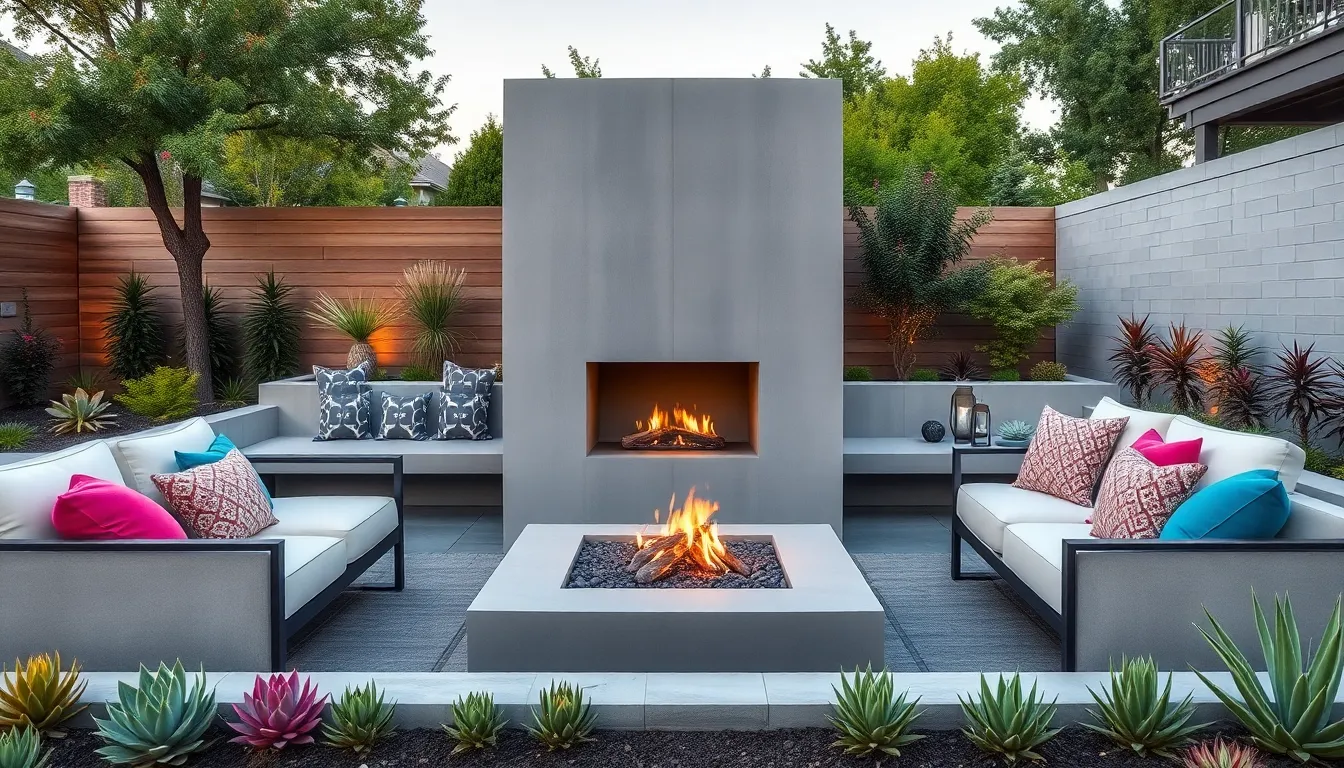
Modern concrete outdoor fireplaces have become the cornerstone of contemporary industry design, offering clean lines and sophisticated aesthetics. These structures prioritize functional beauty with geometric shapes and smooth surfaces that complement minimalist architecture perfectly.
Minimalist Concrete Designs That Make a Statement
Minimalist concrete fireplaces focus on simplicity while creating powerful visual impact through unadorned concrete slabs and monolithic forms. Low-profile rectangular hearths and linear fire features paired with geometric patios exemplify this style, allowing the raw material to speak for itself. Houzz showcases many designs featuring integrated pergolas and open-air layouts that maintain uninterrupted sightlines across outdoor spaces. Many cutting-edge installations in Phoenix and Salt Lake City demonstrate how exposed concrete textures can create compelling focal points without unnecessary ornamentation. Tom Ralston Concrete and Concepts In Concrete Construction have pioneered designs with seamless finishes that highlight concrete’s natural beauty in urban and industrial settings.
Adding Colorful Accents to Concrete Fireplaces
Concrete’s natural gray palette provides the perfect canvas for thoughtful color additions that enhance visual interest without compromising modern appeal. Textured overlays offer a sophisticated approach to introducing variation, with stamped or stained finishes that mimic stone or brick patterns without adding bulk to the streamlined structure. Bright outdoor cushions, ceramic tiles, and metallic fire tools serve as removable accents that can be changed seasonally to refresh your outdoor space. Glass fragments and pigmented aggregates embedded in the concrete create subtle yet striking contrasts that catch light and add dimension. Clark Outdoor Designs recommends balancing industrial minimalism by pairing concrete structures with vibrant landscaping elements such as succulents or patterned tiles around the fireplace area. Modular designs incorporating asymmetrical elements or cantilevered hearths have gained popularity for their architectural interest, especially when combined with integrated seating or lighting features.
Building a Rustic Brick Outdoor Fireplace for Classic Charm
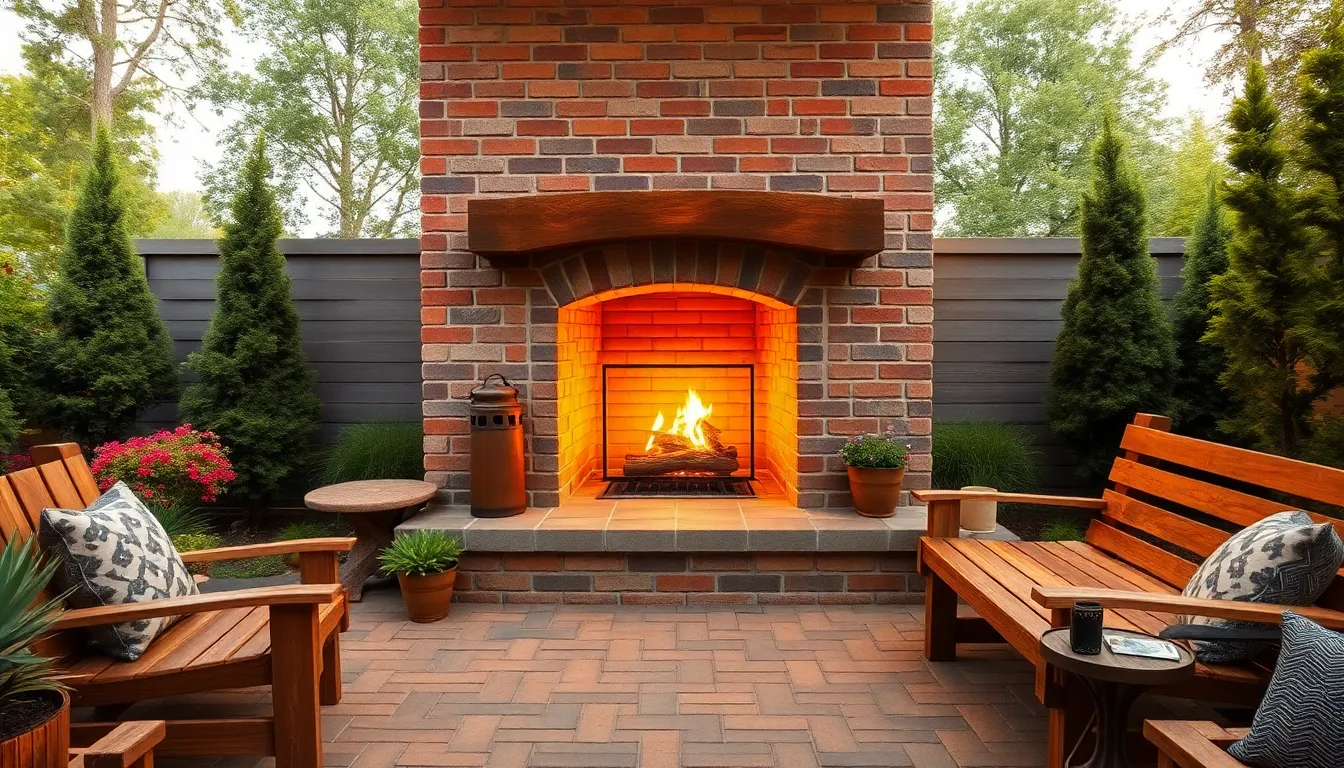
Rustic brick outdoor fireplaces offer timeless appeal with their natural textures and weathered aesthetic. They create focal points that radiate both literal warmth and visual comfort in any outdoor space.
Herringbone and Other Decorative Brick Patterns
Herringbone brickwork transforms standard outdoor fireplaces into sophisticated architectural features. This distinctive pattern creates geometric complexity when applied to firebox interiors, hearths, or surrounding walls. Basketweave arrangements offer a more subtle texture that complements traditional home designs. Running bond patterns provide classic simplicity while maintaining visual interest through horizontal lines. Flemish bond techniques introduce dimension with alternating brick orientations that catch light and create shadow play throughout the day. For maximum visual impact, consider designing brick edges that are slightly recessed or projecting to enhance shadow lines and depth perception. Many homeowners find that decorative patterns work best when concentrated in exact areas rather than covering the entire structure.
Combining Brick With Other Materials for Visual Interest
Blending brick with complementary materials creates ever-changing outdoor fireplace designs that showcase textural contrast. Fieldstone or ledger stone veneers make perfect partners for smooth brick surfaces, especially when applied strategically to fireplace columns or mantels. Concrete elements introduce modern sensibilities through poured hearths or integrated benches that provide both functional seating and minimalist contrast to warm brick tones. Metal details add refinement through steel lintels, copper caps, or decorative iron log holders that weather beautifully over time. Reclaimed timber mantels bring organic warmth that softens the masonry structure while creating visual continuity with adjacent wooden pergolas or outdoor furniture. Location-exact considerations should guide material selection, with particular attention to wind direction for smoke management and freeze-resistant materials for colder climates. Recent design trends favor multifunctional installations that integrate grill stations or pizza ovens alongside traditional fireplaces, maximizing both utility and entertainment value in outdoor living spaces.
Installing a Portable Outdoor Fireplace for Flexibility
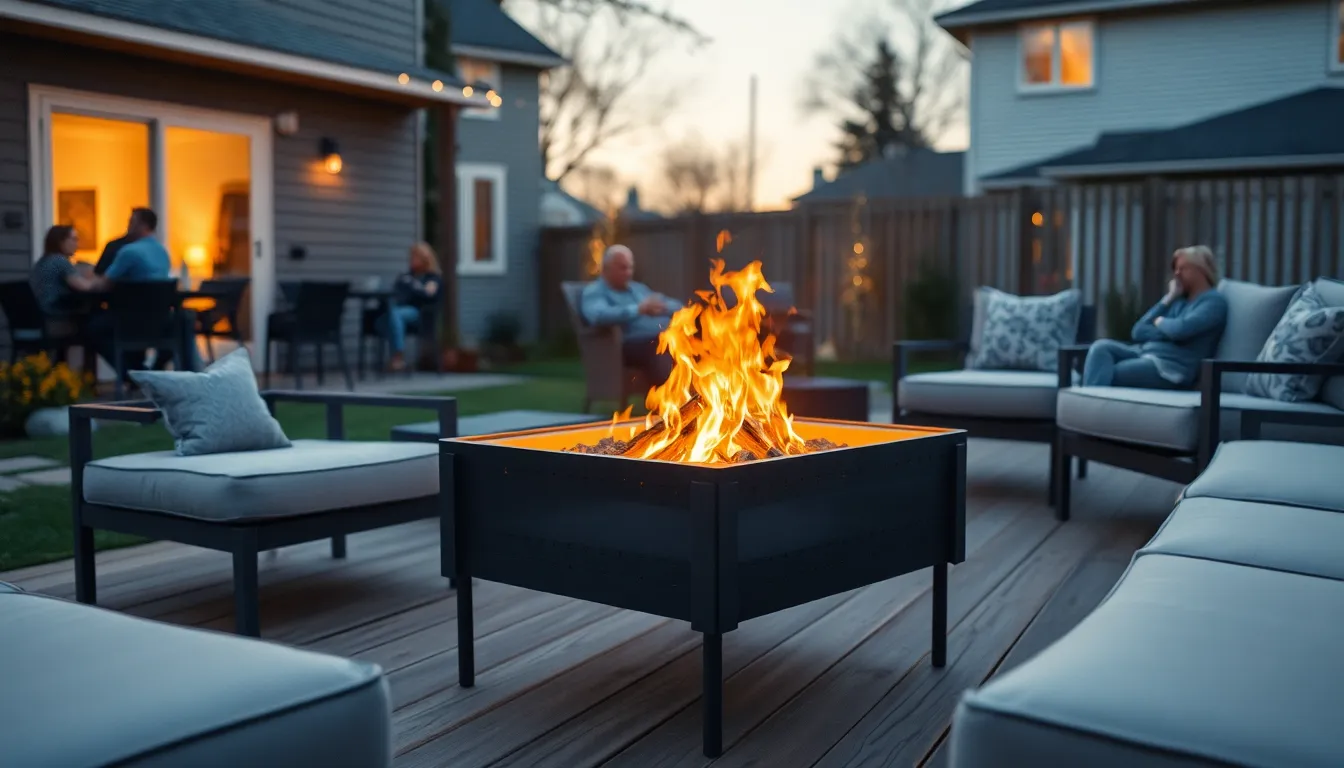
For homeowners who prefer versatility in their outdoor spaces, portable fireplaces offer the perfect solution. These lightweight options allow you to reconfigure your outdoor living area whenever the mood strikes.
Metal Fire Pits and Bowls for Easy Maintenance
Metal fire pits represent one of the most practical portable fireplace options available today. Crafted from corrosion-resistant materials like steel or copper, these units require minimal upkeep while delivering impressive heat output. Many designs come equipped with convenient features such as protective covers and ash collection trays that simplify the cleaning process. The modular nature of these fire pits also accommodates gas line connections for those who prefer flameless operation. DIY enthusiasts can find specialized plans for creating custom metal fire pit surrounds, allowing for personalization while maintaining portability. We particularly appreciate how these units can be repositioned throughout a yard or patio to accommodate different gathering sizes and seasonal preferences.
Tabletop Fireplaces for Intimate Gatherings
Compact bioethanol burners and mini propane fire urns offer the perfect solution for smaller outdoor spaces or more intimate settings. These tabletop units typically measure between 12 and 24 inches wide, making them ideal for placement on dining tables, side tables, or cocktail areas. Safety features abound in these designs, with most incorporating enclosed flames and heat-resistant glass or ceramic housings to prevent accidental contact. Tabletop models create an instant ambiance without the commitment of a permanent installation. Their small footprint allows for seasonal storage when not in use, and many can transition between indoor and outdoor use with proper ventilation. Users particularly value these portable options for small balconies, compact patios, and other limited spaces where traditional fireplaces would be impractical or prohibited.
Embracing Wood-Burning Outdoor Fireplace Designs
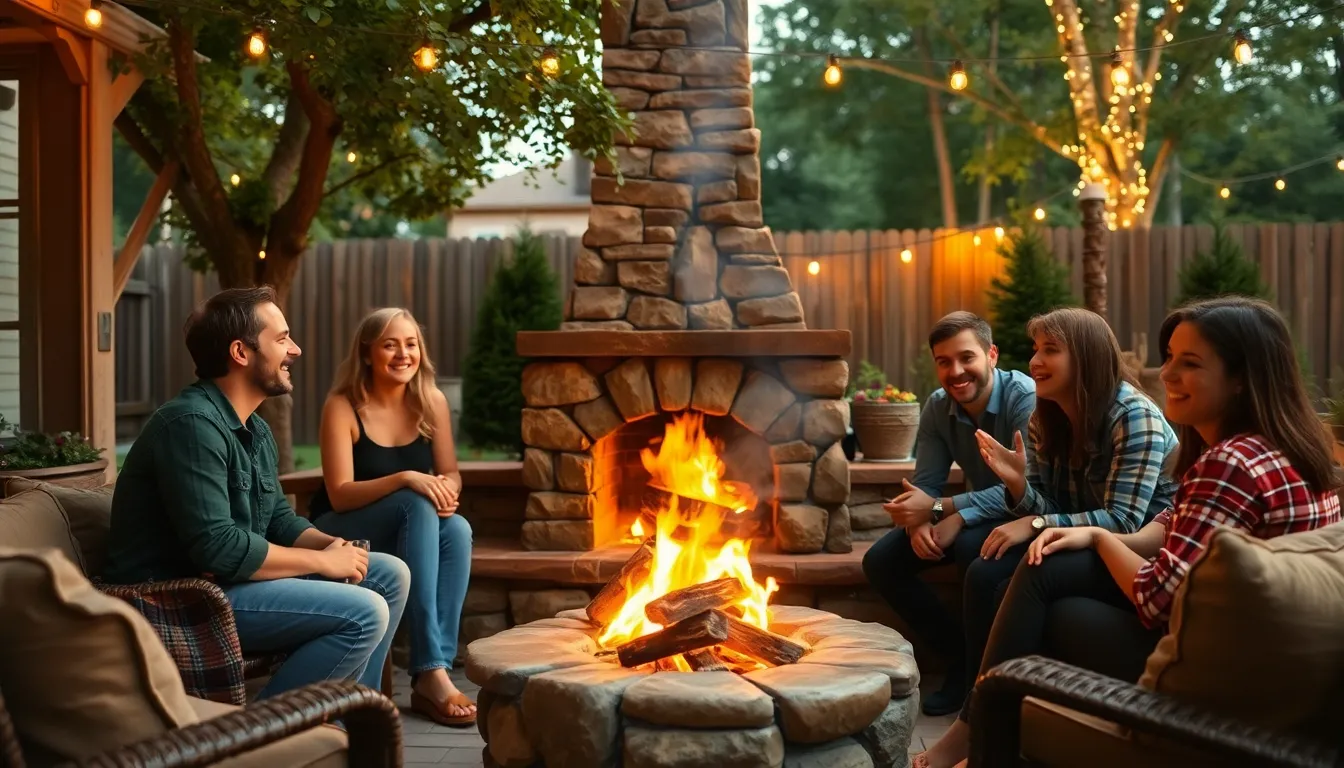
Wood-burning outdoor fireplaces bring unmatched charm and authentic warmth to any outdoor space. These classic installations combine timeless appeal with practical functionality, creating gathering spaces that draw people together throughout the year.
Traditional Open-Hearth Cooking Fireplaces
Traditional open-hearth cooking fireplaces offer dual functionality that transforms your outdoor space into a culinary destination. These versatile installations allow you to enjoy both the comforting warmth of a crackling fire and the unique flavors of flame-cooked meals. Stone and brick variants remain the most popular material choices due to their exceptional durability, natural aesthetic appeal, and minimal maintenance requirements. The rustic charm of open hearth designs makes them perfect centerpieces for outdoor entertaining areas where family and friends can gather for cooking events. Many homeowners incorporate traditional elements like mantle shelving or built-in log storage to enhance both functionality and visual appeal. For authentic cooking experiences, consider adding cast iron accessories, swing-arm pot hangers, or traditional grill grates to maximize your outdoor culinary capabilities.
Properly Ventilated Wood-Burning Structures
Proper ventilation stands as the critical element for safe, enjoyable wood-burning outdoor fireplaces. Well-designed chimney systems ensure smoke directs away from seating areas while improving overall burning efficiency. Professional installation becomes particularly important when handling local building codes and regulations that govern outdoor burning structures. Many prefabricated outdoor fireplace kits now include comprehensive ventilation components that simplify the DIY installation process while maintaining safety standards. Custom designs offer the advantage of customized ventilation answers that account for your exact outdoor environment, prevailing wind patterns, and proximity to structures. The height of the chimney directly impacts draft performance, with taller chimneys typically providing better smoke dispersal in most settings. For areas with close neighbors, enhanced ventilation features help minimize smoke drift that might otherwise create tensions. Incorporating proper ventilation planning during the initial design phase prevents costly modifications and ensures your outdoor fireplace remains a welcome addition to your industry rather than a smoky nuisance.
Exploring Gas-Powered Outdoor Fireplace Options
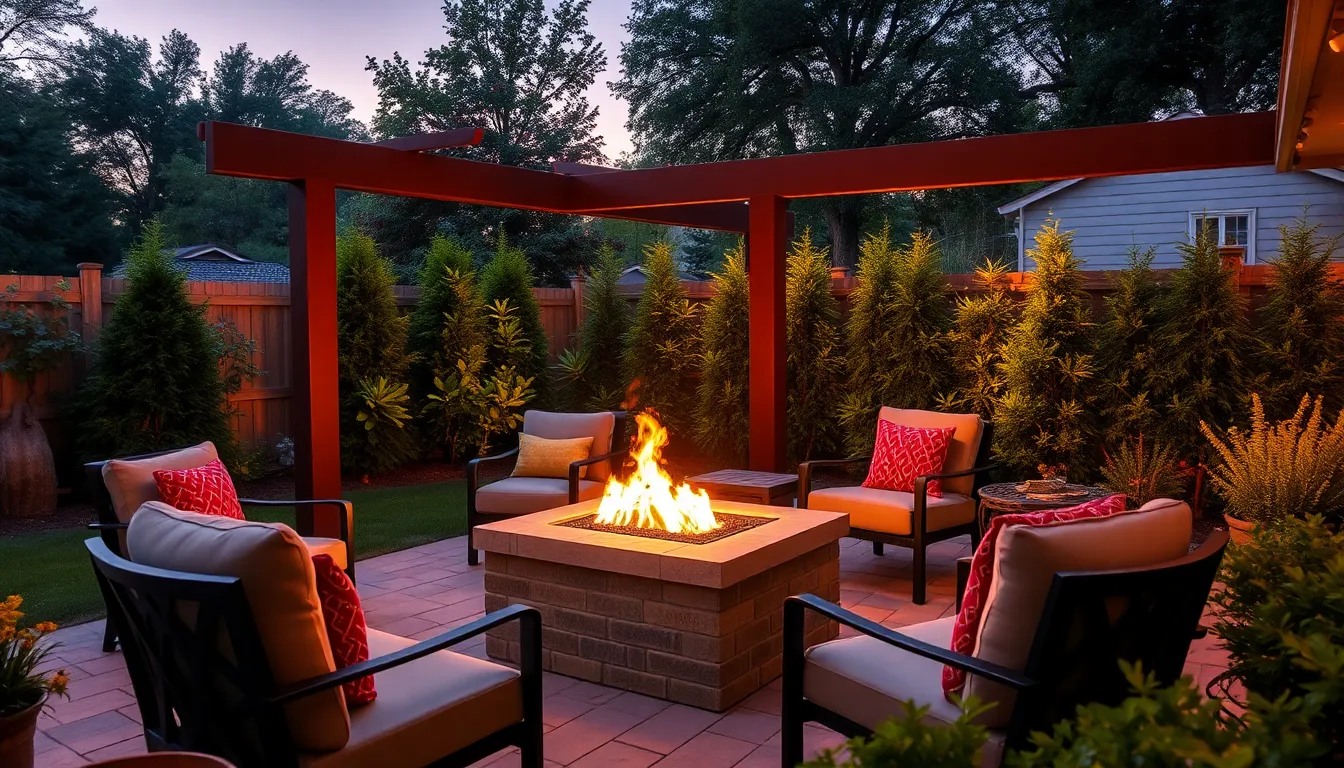
When considering a gas-powered outdoor fireplace, homeowners have excellent options that combine convenience with reliable performance. These systems provide consistent heat without the maintenance requirements of traditional wood-burning alternatives.
Benefits of Propane vs. Natural Gas Systems
Propane systems offer remarkable flexibility for outdoor installations where mobility matters. These units can be placed virtually anywhere in your yard without requiring fixed gas line infrastructure, making them ideal for changing layouts or rental properties. Propane tanks are easily transportable and allow for quick setup in different outdoor environments, perfect for homeowners who enjoy rearranging their outdoor living spaces seasonally.
Natural gas fireplaces deliver continuous energy supply without the hassle of tank replacements or refills. Once installed, these systems connect directly to your home’s existing gas line, providing uninterrupted operation even during extended gatherings or cold-weather use. The long-term cost benefits of natural gas typically outweigh the initial installation investment, making them more economical for permanent outdoor living spaces that see frequent use throughout the year.
Remote-Controlled Features for Convenience
Modern gas-powered outdoor fireplaces now include sophisticated remote-control capabilities that transform the user experience. These smart features allow homeowners to adjust flame height, power the system on or off, and control temperature settings without leaving the comfort of their seating area. Remote functionality enhances safety by providing precise control over the fireplace operation, especially valuable during unexpected weather changes or when entertaining guests.
Many premium models incorporate programmable timers that automatically shut off the system after predetermined periods, conserving fuel and providing peace of mind. Integration with smart home systems has become increasingly common, allowing voice-activated commands through popular platforms to create the perfect outdoor ambiance with minimal effort. These technological enhancements make gas-powered options particularly attractive for homeowners seeking convenience without sacrificing the warm, inviting atmosphere that draws people outdoors year-round.
Creating a Multi-Functional Outdoor Fireplace
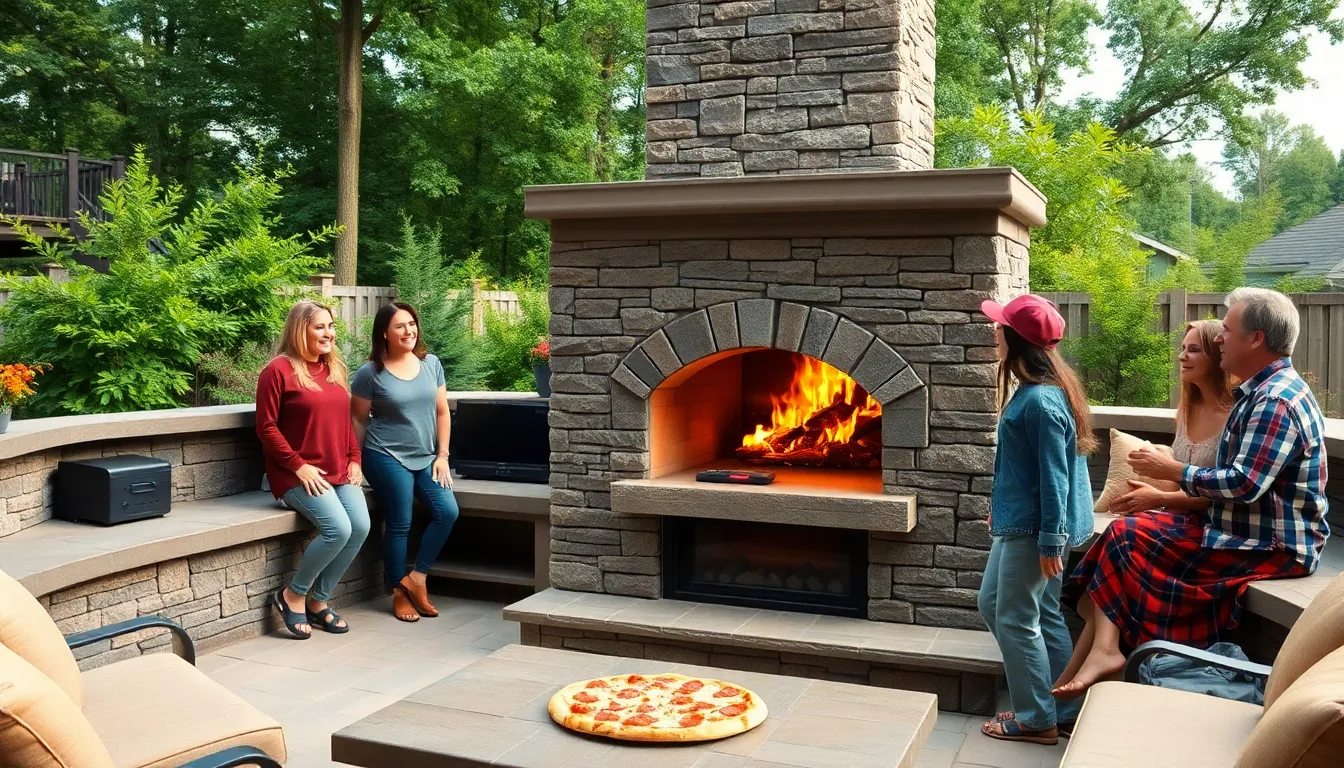
A multi-functional outdoor fireplace transforms your backyard into a versatile entertainment hub. These dual-purpose designs maximize your outdoor space while providing both warmth and utility.
Combining a Fireplace with an Outdoor Kitchen
Fire and food have always been natural companions in outdoor entertaining. Positioning outdoor fireplaces near kitchen areas creates a seamless transition from cooking to dining, allowing hosts to remain engaged with guests throughout meal preparation. See-through fireplace designs effectively connect these spaces while maintaining distinct functional zones.
Open-plan layouts that center around a fireplace encourage social interaction during gatherings. This arrangement maximizes space utilization and creates natural traffic flow between cooking and lounging areas. Your guests can comfortably mingle while meals are prepared, maintaining the social atmosphere throughout the evening.
Built-in seating around the fireplace establishes a cozy gathering area that naturally draws people together. Fire tables offer exceptional versatility, functioning as both heat sources and dining surfaces depending on your needs. These multi-purpose elements create a cohesive outdoor room that accommodates various activities without requiring separate dedicated spaces.
Adding Pizza Ovens to Your Fireplace Design
Pizza ovens elevate ordinary outdoor fireplaces into culinary destinations. Integrated designs that combine a traditional fireplace with a built-in pizza oven create a comprehensive cooking and heating solution perfect for entertaining. Families particularly appreciate these combination units for casual weekend gatherings where food becomes the centerpiece of the experience.
Stand-alone pizza ovens positioned near your existing fireplace offer flexibility when complete integration isn’t feasible. This arrangement maintains a strong culinary focus in your outdoor living area while allowing independent operation of each element. Access paths between cooking zones should be carefully planned to ensure smooth transitions during food preparation and serving.
Mixed materials such as stone, metal, and brick enhance both aesthetics and durability in these combination designs. Blending textures creates visual interest while ensuring your outdoor kitchen fireplace withstands the elements and frequent use. The material palette should harmonize with your existing outdoor architecture for a cohesive look that feels intentional rather than pieced together.
Incorporating Water Features With Your Outdoor Fireplace
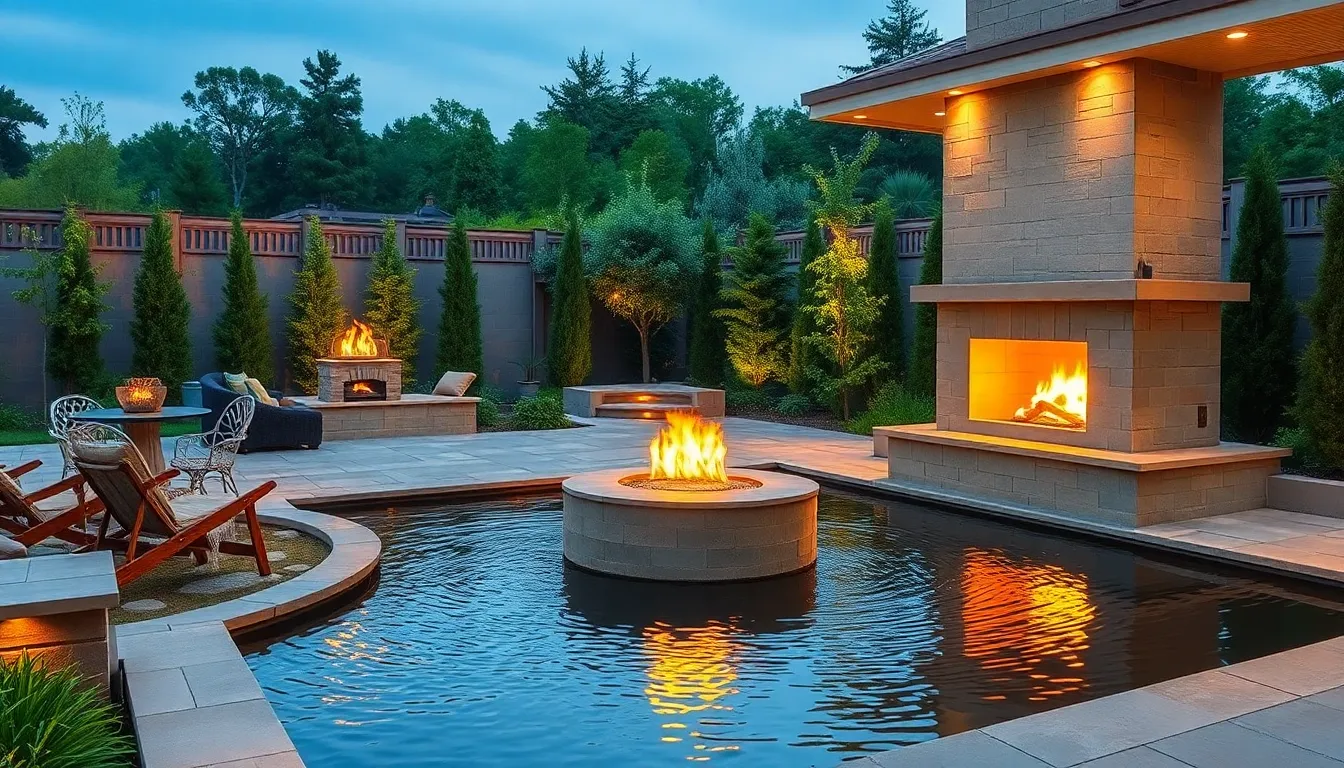
Combining fire and water elements creates one of the most visually captivating outdoor living spaces you can design. These contrasting elements work together to stimulate multiple senses and establish a truly memorable backyard retreat.
Fire and Water Combination Designs
Modern fire-and-water features offer stunning design possibilities that elevate your outdoor space. Dedicated bowls or basins that integrate flames with flowing water provide dual sensory appeal while creating a sophisticated focal point. Cascading waterfalls paired with fire bowls create ever-changing visual interest, especially when flames reflect off the moving water near seating areas. Floating fire bowls on water surfaces like ponds deliver the magical illusion of flames hovering above water—perfect for contemporary or Zen-inspired landscapes. Water walls with integrated fire spouts blend vertical water flows with controlled flames for an ultra-sleek aesthetic that impresses guests. Reflecting pools positioned adjacent to fire features amplify both light and movement, while fountains with embedded fire elements serve as elegant centerpieces that draw the eye. Natural stone fireplaces paired with adjacent streams or fountains create the perfect balance between rugged textures and serene water elements.
Creating Dramatic Lighting Effects
Strategic lighting transforms fire-water combinations into magical nighttime displays. Underwater LED lights illuminate water features while fire bowls cast flickering reflections across the surfaces, creating a mesmerizing play of light. Pathway lighting installed around fireplaces and water edges improves safety after dark while highlighting the textural details of your design elements. Moonlight-style fixtures produce soft ambient glows throughout your industry, intentionally contrasting with the fire’s warmth to create layers of visual depth. Free-standing fire pits positioned near pools or ponds allow simultaneous enjoyment of both elements, with firelight dancing dramatically across water surfaces after sunset. Material consistency between your fireplace and water features—using matching stone or corten steel across both structures—creates a cohesive design language throughout your outdoor space. These thoughtful lighting approaches maximize the impact of combining fire and water elements, transforming ordinary backyards into extraordinary entertainment destinations.
Choosing the Perfect Location for Your Outdoor Fireplace
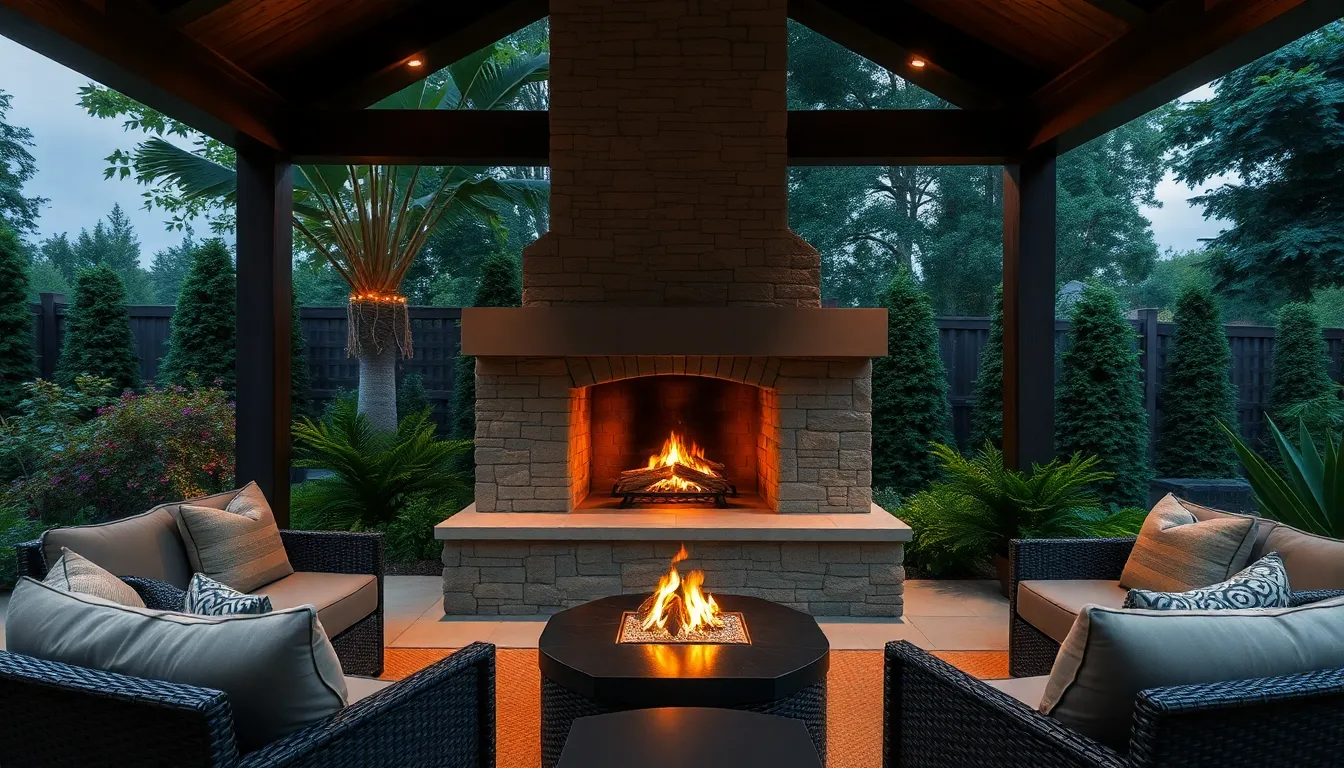
The location of your outdoor fireplace significantly impacts both its functionality and your overall enjoyment. Strategic placement ensures safety, comfort, and maximum use throughout the year.
Considering Wind Patterns and Safety Factors
Wind patterns play a crucial role when positioning your outdoor fireplace. Placing your fireplace with wind direction in mind helps ensure smoke disperses effectively rather than blowing into seating areas where guests gather. Safety must remain a top priority during installation, requiring adequate distance from any flammable structures such as wooden features or low-hanging tree branches. Creating clear paths around your fireplace provides necessary emergency exits and improves accessibility for maintenance. Professional installers often recommend conducting a site assessment that evaluates typical wind flow through your property before finalizing the fireplace location, preventing smoke-related issues that could diminish your outdoor experience.
Maximizing Views and Social Connection
Outdoor fireplaces function best as central gathering points that enhance rather than obstruct your industry views. Position your fireplace where it serves as a natural focal point while maintaining sightlines to attractive garden features or scenic vistas. Many homeowners opt for centrally located fireplaces within dedicated seating areas to foster meaningful conversation and connection among guests. Freestanding fireplace designs offer versatility for spaces that might need occasional reconfiguration based on different entertainment needs. The strategic placement of your outdoor hearth can effectively anchor your patio design, creating a seamless transition between indoor and outdoor living spaces. Adding complementary ambient lighting around the fireplace area enhances its visual impact during evening gatherings while extending usable outdoor hours well into the night.
Essential Maintenance Tips to Preserve Your Outdoor Fireplace Investment
Creating your dream outdoor fireplace is just the beginning of your journey to year-round outdoor enjoyment. We’ve shared many design ideas from classic brick to modern concrete and versatile portable options that can transform any outdoor space.
Remember that regular maintenance will keep your fireplace functioning beautifully for years to come. Schedule seasonal cleanings protect your investment and remove ash buildup from wood-burning units. For gas fireplaces check connections annually to ensure safety.
Whether you’ve chosen a multifunctional entertainment hub a dramatic fire-water combination or a simple portable unit the right placement and care will maximize your enjoyment. With these inspirations and practical considerations we’re confident you’ll create an outdoor hearth that perfectly suits your lifestyle and enhances your home’s value.
Frequently Asked Questions
What are the benefits of having an outdoor fireplace?
An outdoor fireplace enhances both warmth and style in your backyard, effectively creating a year-round retreat. It serves as a focal point for gatherings, extends the usability of your outdoor space into cooler months, and increases your property value. Beyond functionality, it adds architectural interest and creates an inviting atmosphere that encourages outdoor living.
Which materials are best for outdoor fireplaces?
Popular materials include brick (durable and traditional), stone veneer (luxurious appearance at mid-range cost), concrete (modern and sleek), and metal (portable and affordable). For wetter climates, choose water-resistant stones like bluestone or granite. In arid regions, limestone or travertine work well. Your selection should consider local weather conditions, maintenance requirements, and compatibility with your home’s exterior.
How much does it cost to install an outdoor fireplace?
Installation costs vary widely based on materials, size, and complexity. Basic portable fire pits start around $100-$500. Built-in brick or concrete fireplaces typically range from $1,500-$5,000. Custom stone veneer masterpieces can cost $5,000-$15,000 or more. Additional features like pizza ovens, integrated seating, or water elements will increase the price. Always budget for proper foundation work and potential gas line installation.
What’s the difference between wood-burning and gas-powered outdoor fireplaces?
Wood-burning fireplaces offer authentic crackling sounds, aroma, and higher heat output but require more maintenance (ash removal) and proper wood storage. Gas-powered options (natural gas or propane) provide instant flames, cleaner operation, and convenient features like remote controls and timers. They eliminate smoke concerns but lack the traditional campfire experience. Gas models typically cost more initially but require less maintenance long-term.
Do I need a permit to install an outdoor fireplace?
Most localities require permits for permanent outdoor fireplace installations, especially for structures with foundations or gas connections. Requirements vary by location, with many areas having specific regulations about placement distances from structures, chimney height, and fire safety measures. Always check with your local building department and homeowners association before beginning construction to ensure compliance with all codes.
How should I maintain my outdoor fireplace?
Regular maintenance includes removing ash from wood-burning units, checking gas connections for leaks in gas models, and inspecting chimney systems for blockages. Clean stone and brick surfaces with appropriate cleaners to prevent staining. Cover portable units when not in use to protect from elements. For all types, schedule annual professional inspections before heavy use seasons to ensure safe operation and extend lifespan.
Can I have an outdoor fireplace in a small space?
Yes! Small spaces can accommodate tabletop fireplaces, portable fire bowls, or compact chimineas that provide ambiance without requiring significant square footage. Wall-mounted gas fireplaces also work well for limited areas. For balconies or small patios, consider ethanol-fueled tabletop options that don’t require venting. Always verify weight limitations for elevated installations and maintain proper clearance from combustible materials.
Where is the best location to place an outdoor fireplace?
The ideal location considers prevailing wind patterns (to direct smoke away from seating and the house), views from inside and outside the home, and distance from flammable structures. Position your fireplace as a central gathering point with surrounding seating. Consider sun patterns throughout the day and the fireplace’s relationship to other outdoor features like pools or dining areas for a cohesive layout.
Can outdoor fireplaces be used for cooking?
Absolutely! Many outdoor fireplaces can be designed with cooking capabilities. Options include built-in pizza ovens, adjustable grilling grates, rotisserie attachments, or Dutch oven platforms. Traditional open-hearth designs work well for authentic wood-fired cooking. For maximum versatility, consider a multi-functional design that incorporates both a conventional fireplace and dedicated cooking areas with appropriate food preparation surfaces nearby.
How can I enhance my outdoor fireplace design?
Elevate your fireplace design by integrating complementary features like built-in seating, ambient lighting, or water elements. Consider adding decorative screens, distinctive mantels, or unique fire media (colored glass, ceramic balls). Incorporate storage for wood or cooking tools. Surround the area with appropriate landscaping that provides privacy and visual interest through all seasons. Strategic placement of weather-resistant artwork or mirrors can also enhance the space.

